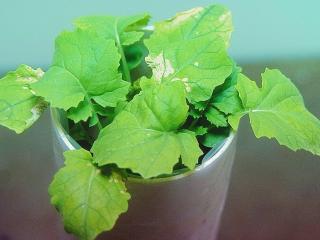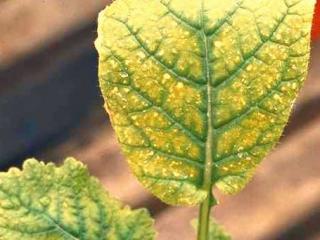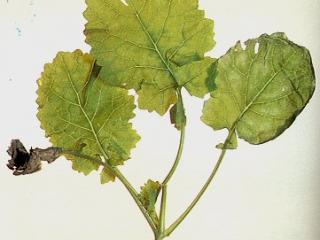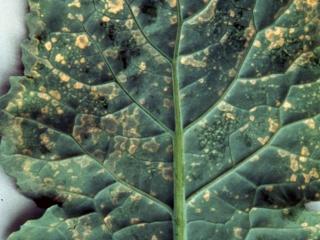Micronutrients in canola
Copper
Interpreting soil and tissue tests
| Yield loss | >25% | 15-25% | 5-15% | <5% |
| Copper 0-10cm soil test (mg/kg) (DTPA) | <0.15 | 0.15-0.25 | 0.25-0.35 | >0.35 |
| Copper in seedling whole tops (mg/kg) | <3.0 | 3.0-4.0 | 4.0-5.0 | >5 |
| Copper in rosette whole tops (mg/kg) | <2.2 | 2.2-3.0 | 3.0-3.6 | >3.6 |
| Copper in youngest emerged leaf (mg/kg) | <2 | 2.0-3.0 | 3.0-4.0 | >4.0 |
- A single application of copper incorporated into soil can prevent deficiency for many years.
- Whole-top plant test provides a rough guide if paired good and poor samples are taken, but this should be confirmed with a youngest emerged leaf test.
Copper in soils and plants
About 8-9 million hectares of Western Australian soils were deficient in copper for agricultural production in their uncleared state. Since clearing, these soils have received widespread application of copper fertiliser at least once and this has allowed large tracts of ‘light land’ in the wheat belt to be used for agricultural production. Copper fertiliser lasts a long time in the soil, so a single application of copper can prevent deficiency for many years and deficiency is now uncommon in canola crops grown in south-west Australia.
Interactions between copper and soil particles (clay, organic matter and iron and aluminium oxides) are complex. The availability of copper to plants would be expected to decrease with liming because in higher pH soils, copper is more strongly bound to soil particles, however, this has not always been observed. Other applied nutrients affect availability of copper to growing crops. For example copper deficiency can be induced in crops if zinc fertilisers are applied, particularly if soil copper levels are marginal. An increase in soil nitrogen either by fertilisation or by mineralisation can also induce copper deficiency in soils with marginal copper concentrations.
The movement of copper in soil is restricted, so it is considered an immobile nutrient. Because of this, applied copper is usually still within in the top 10cm of soil 15 years after the initial application. Therefore top dressing copper fertiliser without cultivation or mixing in the soil profile frequently means that copper is ineffective for crop production. Mixing copper throughout the topsoil makes it more likely that roots will intercept copper mixed through the soil allowing plant uptake.
Copper is adsorbed by plant roots from the soil solution so if it is placed deeper in the profile, where soil is moist for longer, it is more available to the plant resulting in higher plant copper concentrations. The DTPA copper soil test provides a rough guide of the copper status of a soil. Levels of DTPA extractable less than 0.25mg Cu/kg are frequently deficient, with levels of 0.35 adequate for canola production.
Copper is also immobile within plants so deficiency symptoms are usually observed on young leaves and these are the best leaves to sample for plant analysis. The movement of copper in plants was found to parallel nitrogen movement from old to new leaves. Therefore in plants well supplied with nitrogen, where remobilisation of nitrogen is not required from older to younger plant parts, copper also remains in old leaves and new leaves (youngest tissue) may become copper deficient.
Diagnosis and management
For information about diagnosing copper deficiency and to view more images of deficiency symptoms in canola, see DPIRD’s guide to Diagnosing copper deficiency in canola.
A single application of 0.7-1.5kg copper/ha incorporated into copper deficient soils will prevent deficiency of crops for many years as it has a long residual value. As copper is immobile in the soil, incorporation is essential to ensure applied copper does not remain inaccessible to plant roots in the dry top soil.
An alternative is using a compound fertiliser that contains copper, drilled at seeding particularly if DTPA soil test Copper levels are low or plant tissue test from the previous years’ crop indicate low to marginal levels.
Copper foliar sprays can be very effective during the current growing season. However, foliar applications need to be applied before flowering as sufficient copper is required pre-flowering for fertile pollen development. Foliar uptake by leaves is higher in cool and cloudy conditions. A range of products are available for foliar application, with application 125-250g copper/ha, applied in 50-100 litres of water being adequate to correct deficiency. Note that copper sulfate is corrosive and can cause extensive leaf foliage damage, particularly with sprayed a concentration of 2% under sunny conditions.
Copper seed treatment generally does not supply enough copper to meet total plant requirement in the current season. Work with wheat has shown copper seed applications can result in decreased seedling germination under some seasonal conditions, although little research has been done to verify this with canola.
Remedial action
If visual deficiency symptoms or plant tissue tests indicate an in-crop copper deficiency, the only option available to ameliorate deficiency within the current season is applying a copper foliar spray.
Where copper deficiency has occurred, growers should consider a more permanent solution through increasing levels of copper in the soil as outlined in the management section.
Zinc
Interpreting soil and tissue tests
| Yield loss | >25% | 15-25% | 5-15% | <5% |
| Zinc 0-10cm soil test non alkaline soil (mg/kg) (DTPA) | <0.15 | 0.15-0.25 | 0.25-0.35 | >0.35 |
| Zinc 0-10cm soil test alkaline soil (mg/kg) (DTPA) | <0.19 | 0.19-0.31 | 0.31-0.45 | >0.45 |
| Whole top zinc at early rosette stage (mg/kg) | <15 | 15-25 | 25-30 | >30 |
| Zinc in young mature leaf (mg/kg) | <12 | 12-15 | 15-30 | >30 |
- Canola is moderately susceptible to zinc deficiency; however it is rarely seen in Western Australian crops because of fertiliser usage.
- Tissue tests can provide a more accurate indication of zinc status of canola crops than soil testing.
Zinc in soils and plants
Canola is moderately susceptible to zinc deficiency, however it is rarely seen in Western Australian crops because growers have used fertilisers containing zinc in the past and often use compound fertilisers that contain low levels of zinc.
Zinc is immobile within the soil so having zinc distributed through the soil profile makes it more accessible to developing root systems. Zinc availability is linked to soil pH with deficiency more common on soils with pH above 6.0 as zinc is more strongly bound to soil particles in alkaline soils. Therefore, liming of soils can induce zinc deficiency, although this has been rarely seen in WA.
Whilst soil testing can help understand the zinc status of a particular soil, the commonly used DTPA zinc soil test only provides a rough guide. Tissue tests can provide a more accurate indication of zinc status of canola crops.
Diagnosis and management
For information about diagnosing zinc deficiency and to view more images of deficiency symptoms in canola, see DPIRD’s guide to Diagnosing zinc deficiency in canola.
Many growers sow canola crops with a compound nitrogen and phosphorus fertiliser that contain micronutrients (including zinc) and these fertilisers can provide enough zinc to meet the requirements of that season’s crop.
Seed treatment with zinc is sometimes used to promote early growth (seedling vigour) where root disease is a problem, but the quantity of zinc applied to the seed is less than a plant needs in the current season.
A fertiliser containing zinc needs to be drilled (incorporated) in the soil profile for the zinc to be available to plants. As zinc is immobile in the soil, topdressing is ineffective because it is only available to the plant while the topsoil is wet.
Remedial action
If zinc deficiency occurs in a canola crop, growers can apply a zinc foliar spray but it needs to be applied as soon as deficiency is detected to avoid irreversible damage. As the foliar spray is only effective during the current season, growers are advised to use a drill a fertiliser containing zinc with the next crop.
Manganese
Interpreting tissue tests
| Yield loss | >25% | 15-25% | 5-15% | <5% |
| Manganese in whole tops of young plant (mg/kg) | <15 | 15-20 | 20-30 | >30 |
- Canola is less susceptible to manganese deficiency than cereals
- No reliable soil test for manganese exists.
Managanese in soils and plants
Manganese deficiency does occur on gravelly soils of the western fringe of the wheat-belt from Moora in the north through Williams and the Boyup Brook-Kojonup area in the south. Similarly, gravelly soils of the Kukerin – Lake Grace area, the Great Southern and the Esperance sand plain are manganese deficient for crops, particularly in drier years. The deficiency is also occasionally observed in crops grown on neutral to alkaline soil types of the Mallee districts, particularly soils north of the Esperance sandplain. Although canola is less susceptible to manganese deficiency than cereals, deficiency does occur in canola crops grown on susceptible soil types, and occasionally on soils that have recently received a heavy application of lime.
As plant available manganese levels can vary rapidly according to soil conditions, a soil test rarely provides an indication of the potential for deficiency. Manganese becomes readily available to plants as soil moisture increases. Manganese in the soil is regularly measured using the DTPA test but research in WA has shown it does not provide a reliable indication of plant available manganese levels. It is therefore important to tissue test canola growing on soils where manganese deficiency is suspected.
Manganese is a nutrient that causes both deficiency and toxicity canola crops. Although manganese toxicity occurs in acid soils in eastern Australia, manganese toxicity has never been confirmed in field grown canola crops of WA.
Diagnosis and management
For information about diagnosing manganese deficiency and to view more images of deficiency symptoms in canola, see DPIRD’s guide to Diagnosing managanese deficiency in canola.
Remedial action
If manganese deficiency is diagnosed in a canola crop, application of a foliar manganese spray is an effective treatment. A foliar application of 4kg manganese sulfate in 50-100 litres of water per hectare at onset of visual symptoms or tissue analyses diagnosis usually corrects the deficiency. However severely deficient patches may require a second application. Other commercially available manganese products should be applied at 1kg manganese per hectare which is the equivalent of 4kg per hectare of manganese sulfate.
Molybdenum
Interpreting tissue tests
| Yield loss | >25% | 15-25% | 5-15% | <5% |
| Molybdenum in whole tops of young plant (mg/kg) | <0.05 | 0.05-0.1 | 0.1-0.15 | >0.15 |
- Despite many soils being naturally deficient in molybdenum, deficiency has not been diagnosed in canola in Western Australia and there is limited data showing a response to molybdenum fertiliser.
- Molybdenum is less available in acidic soils so liming to maintain topsoil pH above 5.5 is important for maintaining availability.
- There is no available soil test for molybdenum.
Molybdenum in soils and plants
Many slightly acidic to acidic sandplain soils and gravelly sands in WA were molybdenum deficient in their natural state. Application of molybdenum in fertiliser has corrected molybdenum deficiency in many of these soils and deficiency in canola has not been diagnosed in the field in WA. There is however, no reliable soil test for molybdenum.
The risk of deficiency increases on soils that have become more acidic because deficiency is exacerbated at low pH and on soils high in iron and aluminium oxides. However, canola is poorly adapted to acidic soils where molybdenum deficiency would occur so deficiency is difficult to detect in the field.
Maintaining a surface pH above 5.5 through liming is generally accepted to decrease subsoil acidity and this will increase molybdenum availability and ensure no additional molybdenum fertiliser is required.
Diagnosis and management
For more information, and to view images of molybdenum deficiency symptoms in canola, see DPIRD’s guide to Diagnosing molybdenum deficiency in canola.
To confirm a suspected case of molybdenum deficiency, sample whole young plants and take paired good and poor plant samples if possible, although few responses to molybdenum application have been recorded.
Molybdenum deficiency can be prevented by the strategic use of fertilisers containing molybdenum. As molybdenum is immobile in the soil, topdressing is ineffective, as it is only available to the plant while the topsoil is wet. Drilling of molybdenum fertiliser in the soil profile or using a molybdenum seed treatment can ensure availability.
Because molybdenum is less available in acidic soils, liming to maintain topsoil pH above 5.5 is important for maintaining molybdenum availability.
Remedial action
Application of a foliar spray can correct the deficiency and is usually applied as sodium molybdate. Because the foliar spray is effective only in the current season, the following crop may require molybdenum fertiliser. If soil pH is below 4.7, consideration should be given to correction of soil acidity. Molybdenum fertiliser can remain available for several years; however the length of time is dependent on the soil pH. In strongly acid soils molybdenum fertiliser may only remain available for one year.
Boron
Interpreting soil tests
| Yield loss | >25% | 15-25% | 5-15% | <5% |
| Boron 0-10cm soil test (mg/kg) (in CaCl2) | <0.3 | - | - | 0.3-0.5 |
| Yield loss | <5% | 5-15% | 15-25% | >25 |
| Boron 10-20cm soil test (mg/kg) (in CaCl2) | 4-18 | 18-25 | 25-30 | >30 |
| Boron 20-30cm soil test (mg/kg) (in CaCl2) | 4-18 | 18-25 | 25-30 | >30 |
| Boron 30-40cm soil test (mg/kg) (in CaCl2) | 4-18 | 18-25 | 25-30 | >30 |
- Boron can cause both deficiency and toxicity symptoms on different Western Australian soil types, although deficiency is extremely rare.
- Crop varieties may differ in their susceptibility to boron toxicity although we do not have information on the relative susceptibility or tolerance of current canola cultivars.
- There is limited data on critical levels of plant boron for toxicity in canola in WA.
Boron in soils and plants
Boron is an essential nutrient for plant growth and can cause both deficiency and toxicity symptoms on different Western Australian soil types although deficiency is rare. The alkaline, sodic soils most commonly associated with boron toxicity in South Australia are also widespread in the medium to low rainfall areas of WA and this is where boron toxicity of cereals has been reported. Symptoms of boron toxicity are also observed in canola grown on these soil types.
Boron is highly immobile within plants and sampling the whole shoots of plants is unreliable in predicting both boron deficiency and toxicity. As boron is immobile, the youngest leaf or young tissue has been found to be a reliable indicator of boron deficiency in canola.
Soil testing can identify soils with low levels of boron in the surface soil profile that have the potential to develop deficiency in canola. Research has not yet been able to accurately predict which soils will respond to boron application. Similarly, soil testing can identify soils with high levels of boron in the subsoil that have the potential to develop toxicity symptoms in canola. A difficulty for soil testing is that concentrations of boron can vary spatially across a paddock and down the soil profile making diagnosis by soil sampling difficult.
The impact on crop growth depends on the severity of the toxicity, but is also affected by the distribution of boron in the soil. For example, high boron concentration at depth is likely to have less detrimental effect if the plant roots do not have to explore those soil depths for water. If surface soil profiles dry, canola plant roots explore greater soil depth for water and boron uptake increases as a result promoting boron toxicity.
As there have been few responses to boron fertiliser or boron foliar application for canola; particularly for crops grown on low soil boron soils, there is no calibrated soil test for boron deficiency. Soil testing may be useful on deep acidic sands with low clay and low organic carbon but on duplex soils subsoil boron levels should also be determined. In recent years, research on 30 canola crops grown on soils where boron deficiency would be anticipated have shown no response to boron fertiliser or sprays despite soil tests having very low boron levels (around 0.3 mg/kg boron).
Elevated boron levels can also reduce calcium absorption in canola which may induce calcium deficiency/tipple topple. For more information about diagnosing calcium deficiency and to view images of deficiency symptoms in canola, see DPIRD’s guide to Diagnosing calcium deficiency in canola.
Diagnosis and management
For more information about diagnosing boron deficiency and to view more images of deficiency symptoms in canola, see DPIRD’s guide to Diagnosing boron deficiency in canola.
As boron is less available in acidic soils, liming to maintain topsoil pH can increase soil boron availability.
Management options for boron toxicity are limited to using tolerant crops and genotypes. We do not have information on the relative susceptibility or tolerance of current canola cultivars to boron toxicity.
Remedial action
Boron deficiency can be corrected by soil or foliar applications of boron. Soil applications generally last longer but can be leached from acidic, sandy soils. Boron, supplied as borax is very toxic to seedling germination and seed yield can greatly be reduced if higher rates than necessary are applied.
There are no in crop remedial actions for boron toxicity. For information about remedial actions for boron deficiency, see management strategies section above.





